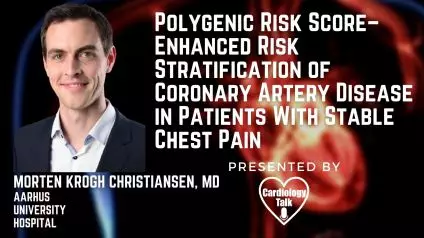Morten Krogh Christiansen, MD @MortenKroughChr1 @AUHdk @AUHCardio #AHAArticle #CoronaryArteryDisease #Cardiology #Res...
Morten Krogh Christiansen, MD, Department of Cardiology, Aarhus University Hospital, Aarhus, Denmark speaks about Polygenic Risk Score–Enhanced Risk Stratification of Coronary Artery Disease in Patients With Stable Chest Pain.
Link to AHA Article:
https://www.ahajournals.org/doi/abs/10.1161/CIRCGEN.120.003298
Summary -
Backstory:
Although polygenic risk scores (PRSs) have been linked to coronary artery disease (CAD), the therapeutic utility of utilizing PRSs for risk stratification at the single-patient level has yet to be determined. We wanted to see if adding a PRS to clinical risk factors (CRFs) improved risk classification in individuals who were referred for coronary computed tomography angiography because they were suspected of having obstructive CAD.
Methodologies:
We recruited 1617 patients with stable chest symptoms and no history of CAD who were referred for coronary computed tomography angiography in this prespecified diagnostic substudy of the Dan-NICAD trial (Danish study of Non-Invasive testing in Coronary Artery Disease). Age, sex, symptoms, past or active smoking, antihypertensive medication, lipid-lowering treatment, and diabetes were all utilized as CRFs for risk classification. Patients' genotypes were also determined, as well as their PRSs. A coronary computed CT angiography was performed on all of the patients. Invasive coronary angiography with fractional flow reserve was also performed on patients suspected of having a 50% stenosis. Visual invasive coronary angiography stenosis >90%, fractional flow reserve 0.80, or quantitative coronary analysis stenosis >50% if fractional flow reserve measurements were not possible were used to establish a combined endpoint of obstructive CAD.
Outcomes:
Independent of CRFs, the PRS was linked to obstructive CAD (adjusted odds ratio, 1.8 [95 percent CI, 1.5–2.2] per SD). The PRS showed a 0.63 (0.59–0.68) area under the curve, which was similar to that of age and sex. When the PRS and CRFs were combined, the CRF+PRS model had an AUC of 0.75 (0.71–0.79), which was 0.04 higher than the CRF model (P=0.0029). The use of pretest probability (pretest probability) cutoffs of 5% and 15% resulted in a net reclassification improvement of 15.8% (P=3.1104), with a down-classification of risk in 24 percent of patients (211 of 862) who had a pretest probability of 5% to 15% based on CRFs alone.
Findings:
Beyond CRFs, adding a PRS enhanced risk classification of obstructive CAD, indicating that PRSs might be used to guide diagnostic testing in the modern clinical context.




